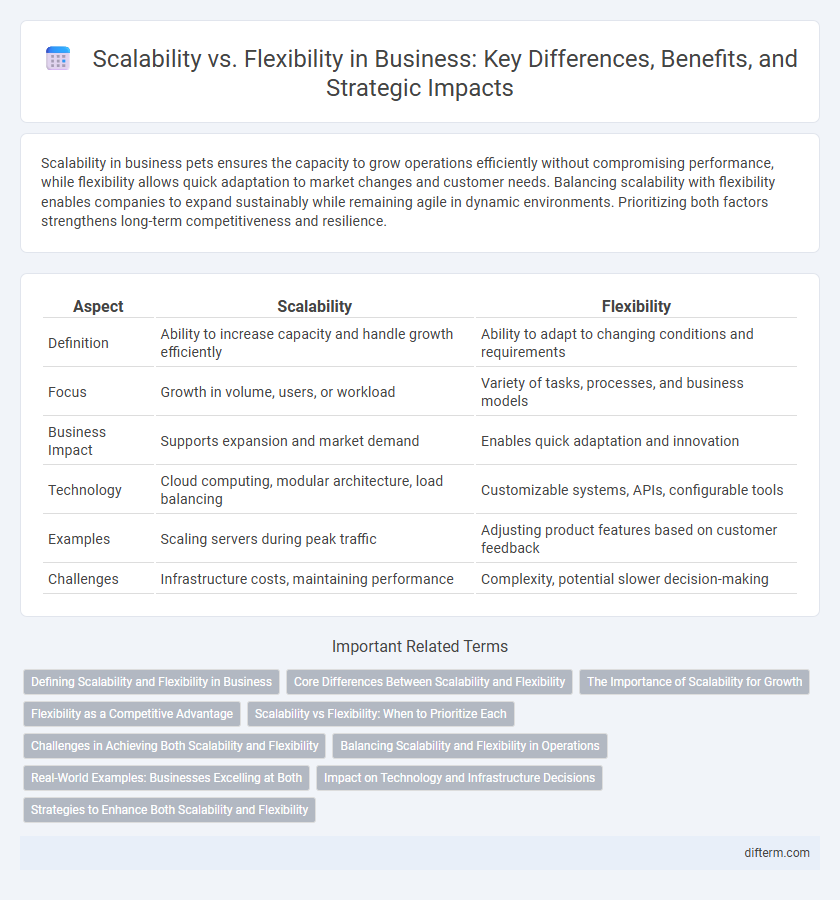Scalability in business pets ensures the capacity to grow operations efficiently without compromising performance, while flexibility allows quick adaptation to market changes and customer needs. Balancing scalability with flexibility enables companies to expand sustainably while remaining agile in dynamic environments. Prioritizing both factors strengthens long-term competitiveness and resilience.
Table of Comparison
| Aspect | Scalability | Flexibility |
|---|---|---|
| Definition | Ability to increase capacity and handle growth efficiently | Ability to adapt to changing conditions and requirements |
| Focus | Growth in volume, users, or workload | Variety of tasks, processes, and business models |
| Business Impact | Supports expansion and market demand | Enables quick adaptation and innovation |
| Technology | Cloud computing, modular architecture, load balancing | Customizable systems, APIs, configurable tools |
| Examples | Scaling servers during peak traffic | Adjusting product features based on customer feedback |
| Challenges | Infrastructure costs, maintaining performance | Complexity, potential slower decision-making |
Defining Scalability and Flexibility in Business
Scalability in business refers to the capacity of a company to handle increased demand, revenue, or operations without compromising performance or losing profitability, often through systematic expansion of resources and processes. Flexibility, on the other hand, denotes a business's ability to quickly adapt to changing market conditions, customer needs, or unexpected challenges by modifying strategies, structures, or operations. Understanding the balance between scalability and flexibility enables businesses to grow sustainably while remaining agile in dynamic environments.
Core Differences Between Scalability and Flexibility
Scalability in business refers to a system's capacity to handle increasing workloads or expand operations without performance loss, whereas flexibility denotes the ability to adapt quickly to changing market conditions or customer demands. Scalability is measured by resource augmentation and process efficiency under growth, while flexibility is evaluated by responsiveness and ease of modification in products or services. Core differences lie in scalability's focus on quantitative growth and infrastructure scaling, contrasting with flexibility's emphasis on qualitative adaptability and innovation.
The Importance of Scalability for Growth
Scalability is critical for business growth as it enables a company to handle increasing workloads and customer demands without compromising performance or quality. Flexible systems support rapid adaptation to market changes, but scalable infrastructure ensures sustainable expansion and long-term profitability. Investing in scalable technology and processes allows businesses to streamline operations and maximize growth potential effectively.
Flexibility as a Competitive Advantage
Flexibility in business operations allows companies to adapt quickly to market changes, customer demands, and emerging technologies, providing a critical competitive advantage over rigid, scalable models. Agile workflows and customizable solutions enable organizations to respond dynamically to disruptions without compromising quality or efficiency. This adaptive capacity supports sustained innovation, customer satisfaction, and long-term growth in volatile business environments.
Scalability vs Flexibility: When to Prioritize Each
Scalability drives sustained growth by enabling systems to handle increased workloads without performance loss, essential for businesses expecting rapid expansion or seasonal demand spikes. Flexibility prioritizes adaptability, allowing companies to pivot quickly and customize solutions in dynamic markets or during innovation phases. When forecasting steady growth or volume-based success, prioritize scalability; when operating in volatile industries or fostering innovation, emphasize flexibility.
Challenges in Achieving Both Scalability and Flexibility
Achieving both scalability and flexibility in business operations presents significant challenges due to conflicting resource allocation demands and operational complexity. Scalability requires standardized processes and robust infrastructure, which can limit the adaptability and customization needed for flexibility. Balancing these priorities often leads to increased costs, slower decision-making, and potential compromises in innovation and customer responsiveness.
Balancing Scalability and Flexibility in Operations
Balancing scalability and flexibility in operations requires designing systems that can efficiently handle increased workloads while adapting to changing market demands. Implementing modular processes and leveraging cloud-based infrastructure allows businesses to expand capacity without sacrificing agility. Prioritizing scalable technologies alongside flexible workflows ensures sustainable growth and operational resilience.
Real-World Examples: Businesses Excelling at Both
Amazon exemplifies scalability and flexibility by efficiently managing vast global operations while quickly adapting to market changes like the rise of e-commerce and cloud computing with AWS. Netflix scales its streaming service to millions of users worldwide and flexes content offerings based on regional preferences and emerging viewer trends. Shopify allows small businesses to scale online sales rapidly while maintaining platform customization to suit diverse merchant needs and market dynamics.
Impact on Technology and Infrastructure Decisions
Scalability drives technology and infrastructure decisions by prioritizing systems that handle increasing workloads efficiently, such as cloud-based platforms and modular architectures. Flexibility influences the adoption of adaptable technologies allowing quick pivots, including microservices and containerization. Balancing scalability and flexibility ensures infrastructure supports growth while accommodating evolving business requirements.
Strategies to Enhance Both Scalability and Flexibility
Implementing modular architecture in business operations allows companies to scale efficiently while maintaining operational flexibility. Leveraging cloud computing resources supports dynamic workload management, enabling rapid adaptation to market changes without compromising scalability. Developing cross-functional teams with adaptive skill sets ensures that organizational growth is met with agility and resilience in decision-making processes.
scalability vs flexibility Infographic

 difterm.com
difterm.com